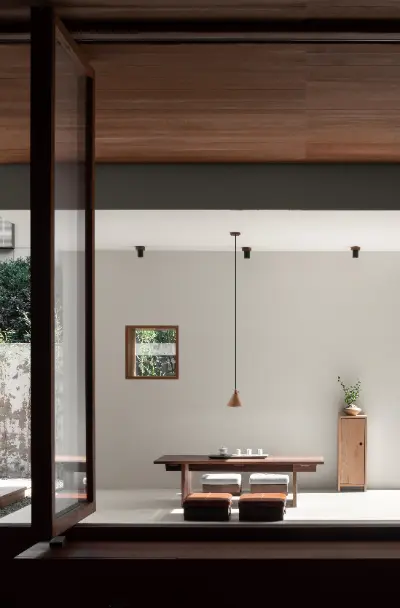南京木墨展厅

下载所需积分: 1
使用木材作为墨水来描绘生活。使用木制家具作为媒介来表达你对生活的理解,以自由的方式进行设计,打造一个环保、自然和健康的空间。只使用木制品来创建空间,不使用油漆和色彩。
项目的位置是老建筑一楼一侧的街道空间。严格来说,这不是一座完整的老建筑。早期,它是中华民国时期江南造币厂的车间。在改造期间,内部建造了一座新的办公楼,只留下了几根高耸的红砖墙。红砖墙上的窗户连接了墙两侧的景色。外面是城市。内部是现代建筑,与砖墙分隔开。它们之间的间隙形成了过渡空间。
这是FANAF在L.Park的第五个项目。前四个项目主要是对内部进行改造,门面改造较少,主要是对城市做出响应。
与以往的项目不同,新项目面对城市的是红砖墙。真正提供功能性的建筑立面位于新项目的内部。间隙和红砖墙共同形成建筑边界。这为我们探索城市与建筑之间的新界面关系提供了适当的机会。
作为历史遗迹,红砖墙得到了保护、修复和维护,成为当代城市的必要文化特征。它讲述了过去的故事,也是改造设计的背景。因此,我们主要关注一楼立面和一楼立面与红砖墙之间的间隙。我们将间隙分为入口庭院和内部庭院。同时,将不同的住宅功能放置在两个庭院中,以打破立面边界,重新构造和模糊建筑边界。
设计独立提取了住宅空间中涵盖的“书房、厨房、卧室、客厅、茶室”等功能,展现了不同的开放表面。
两个庭院以稍微不同的方式模糊建筑边界。在入口庭院中,黑色盒子嵌入建筑内部,一半为室内,另一半通过整个无框玻璃延伸到庭院。建筑内部的世界通过红砖墙上的窗户渗透到城市中。城市的景色也通过黑匣子的玻璃幕墙在窗户上反射出浪漫和活力。
在内部庭院中,室内原木天花板延伸到庭院,新立面隐藏起来,将室内外空间融为一体。C型茶室位于庭院中,分隔了外部城市环境,使透明空间内向化。
两个庭院、两个盒子和两种模糊,加上红砖墙,形成了城市与建筑之间的新界面。它解构了原始的建筑边界,使其立体化、相对化和模糊化。
历史与当代的对抗导致了时间和空间的变化和融合,边界的多重含义不再清晰和明确。因此,身处其中的人不受传统概念的束缚,获得了身心双重的自由。
当界面关系不再清晰时,建筑的内外变得模糊,空间开始穿透,花园的感觉就会出现。
樱桃原木被用来将新添加的形状与原有结构分隔开来,清晰地表明新旧结构之间的关系,并创建一个新的气候边界。
Use wood as ink to depict life. Use wooden furniture as a medium to express your understanding of life, design in a free way, and build an environment-friendly, natural and healthy space. Only wood works are used to create space, and paint and color are not used.
The location of the project is the street space on one side of the first floor of the old building. Strictly speaking, this is not a complete old building. In the early period, it was the workshop of Jiangnan Mintage in the Republic of China. During the transformation, a new office building was built inside, leaving only a few towering red brick walls. The windows on the red brick wall connect the scenery on both sides of the wall. The outside is the city. The contemporary buildings on the inside are separated from the brick wall. The gap between them forms a transitional space.
This is FANAF's fifth project in L.Park. The first four projects are the reconstruction of MOTIVA Gymnasium, Jiangnan Mintage Museum, Aritco Elevator Exhibition Hall, and the lobby of Building 20, which are mainly internal reconstruction, with less facade reconstruction responding to the city.
Different from the previous projects, the new project faces the city with red brick walls. The building facade that really provides functionality is on the inside of the new project. The gap and the red brick wall together form the building boundary. This provides a suitable opportunity for us to explore the new interface relationship between city and architecture.
As a historical relic, the red brick wall has been preserved, repaired and maintained, becoming a necessary cultural feature of the contemporary city. It tells a story of the past and is also the background of the transformation design. Therefore, we mainly focus on the first floor elevation and the gap between the first floor elevation and the red brick wall. We separate the gap into the entrance courtyard and the internal courtyard. At the same time, different residential functions are placed in the two courtyards to break the facade boundary, so as to reconstruct and blur the architectural boundary.
The design independently extracts the functions of "study, kitchen, bedroom, living room, tea room" and other functions covered in the residential space to show different open surfaces.
The two courtyards have slightly different ways of blurring architectural boundaries. In the entrance courtyard, the black box is embedded in the building, half of which is indoor, and the other half extends to the courtyard with a whole side of frameless glass. The world inside the building is laid out and infiltrates the city through the windows on the red brick wall. The scenery of the city also reflects romance and vitality on the glass facade of the black box through the window.
In the internal courtyard, the indoor log ceiling extends to the courtyard, and the new facade is hidden to integrate the indoor and outdoor spaces. The C-shaped teahouse is located in the courtyard, dividing the external urban environment and making the transparent space introverted. Two courtyards, two boxes and two blurs, together with the red brick walls, form a new interface between city and architecture. It deconstructs the original architectural boundary and makes it three-dimensional, relative and fuzzy.
The confrontation between history and the contemporary has resulted in the change and blending of time and space, and the multiple meanings of the boundary are no longer clear and definite. Therefore, people who are in it are not bound by the conventional concepts, and obtain the dual freedom of body and spirit.
When the interface relationship is no longer clear, the interior and exterior of the building become blurred, and the space begins to penetrate, the sense of the garden appears.
Cherry logs are used to separate the newly added shape from the original structure, making clear the relationship between the new and old structures and creating a new climate boundary.